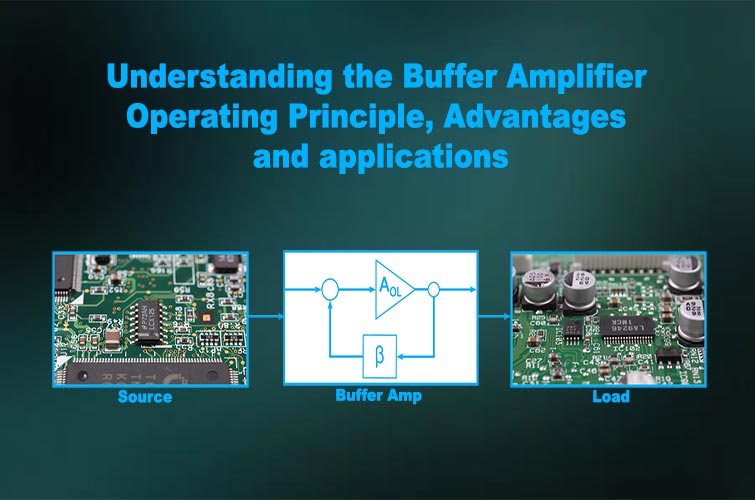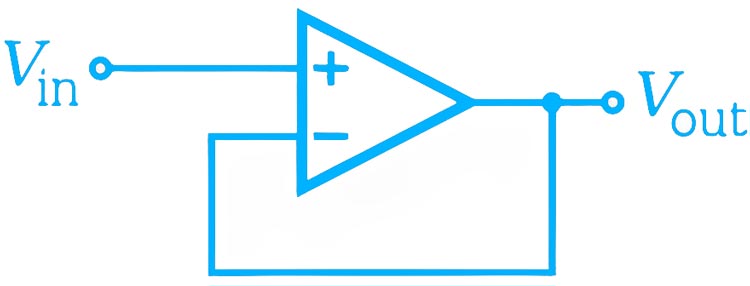Optimized at frequencies beyond traditional industry targets to support emerging applications
Understanding Buffer Amplifier Operating Principle, Advantages and Applications

A buffer amplifier or simply a buffer is a small circuit that provides electrical impedance transformation from one circuit to another. It is mainly used in between different signal stages or in between two circuits with different impedance characteristics. It is mainly used for preventing the source from any current or voltage that the load may impose. In this article, we will discuss about buffer amplifiers, their operation, applications, and advantages. There are mainly two types of buffers exists, the voltage buffer and the current buffer.

Voltage Buffer Amplifier
A voltage buffer amplifier serves the purpose of transferring a voltage from a circuit with a high output impedance to another circuit with a low input impedance. By inserting the buffer between these two circuits, it prevents the second circuit from excessively loading the first circuit, which could interfere with its intended operation. In the ideal scenario, the voltage buffer has infinite input resistance and zero output resistance, effectively behaving like an ideal voltage source with perfect linearity and an instantaneous output response. The voltage buffer can be a unity gain buffer, commonly referred to as a voltage follower, where the output voltage faithfully tracks the input voltage. Even though the voltage gain of the buffer is approximately unity, it often provides significant current and power gain. Nevertheless, it is typically described as having a gain of 1 (or 0 dB), referring to its voltage gain.
Current Buffer Amplifier
A current buffer amplifier is utilized when transferring current from a circuit with low output impedance to another circuit with high input impedance. Its purpose is to prevent the second circuit from excessively loading the first circuit's current, thus avoiding interference with the intended operation. In the ideal configuration, the current buffer has infinite output impedance (acting like an ideal current source) and zero input impedance (acting like a short circuit). Like the voltage buffer, the ideal current buffer exhibits perfect linearity and instant output response regardless of signal amplitudes or input signal speed. For a current buffer, if the current is transferred unchanged (current gain βi is 1), it functions as a unity gain buffer known as a current follower. The output current follows the input current without any division or alteration.
Operating Principle
The buffer amplifier is a non-inverting amplifier with a gain of one (unity gain). It utilizes an operational amplifier (op-amp) as its core element. An op-amp is a high-gain differential amplifier with two inputs (inverting and non-inverting) and a single output. The input voltage is fed to the non-inverting input terminal, while the inverting terminal is typically grounded. Due to its extremely high open-loop gain, the op-amp drives its output to a voltage that effectively eliminates the voltage difference between its inputs. As a result, the output voltage follows the input voltage with a gain of one.
Advantages of Buffer Amplifiers
- Impedance Matching: One of the primary advantages of buffer amplifiers is their ability to act as an impedance buffer. They have a very high input impedance, meaning they draw minimal current from the source. At the same time, their output impedance is very low, allowing them to drive low-impedance loads without significant signal degradation.
- Signal Isolation: Buffer amplifiers provide isolation between input and output circuits. When connecting different components with varying input and output impedances, the buffer ensures that each circuit operates independently, preventing undesired interactions.
- Signal Amplification: Although buffer amplifiers have a unity gain, they are often used in conjunction with other amplifiers in a cascaded setup. Their primary function is to maintain signal integrity and minimize signal distortion, making them essential for signal chains.
Applications
Here are some of the areas where the buffer amplifiers are used:
- Audio Systems: Buffer amplifiers are widely used in audio applications to match impedance between audio sources, such as microphones or musical instruments, and audio receivers or recording equipment. They ensure minimal signal loss and maximize fidelity.
- Sensor Interfaces: In sensor applications, such as temperature sensors or pressure sensors, buffer amplifiers are employed to convert the high impedance output of the sensor into a low impedance signal that can be easily transmitted over longer distances without distortion.
- Voltage Regulation: Buffer amplifiers are also found in voltage regulation circuits where they act as voltage followers, providing stable and well-regulated output voltages that mimic the input voltage.
- Active Filters: Buffer amplifiers are used in active filter circuits to isolate the filter's passband from the load, preventing loading effects that could alter the filter characteristics.
Buffer Amplifier Circuits
A basic buffer amplifier circuit consists of an op-amp with its non-inverting input connected to the signal source and the inverting input grounded. The output of the op-amp is directly fed back to its inverting input, providing a unity gain. Additionally, appropriate power supply connections ensure proper functioning.

Conclusion
In conclusion, the buffer amplifier is a critical component in various electronic applications, facilitating impedance matching, signal isolation, and voltage regulation. Its role as a unity gain amplifier ensures minimal signal distortion, making it indispensable in many electronic signal processing circuits. As technology continues to advance, the buffer amplifier's importance is expected to grow further, enhancing signal integrity and improving overall system performance.








